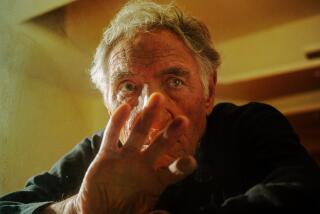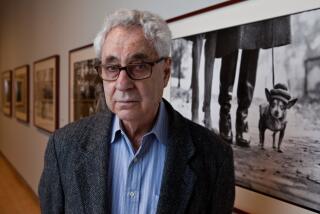A Combat Photographer’s Last Call to Duty
- Share via
ABOARD USS MISSOURI — They were together in the beginning. Charlie Potts and the Missouri. He was a World War II combat photographer. Her quarter-deck was the 1945 backdrop for his everlasting cinematography of the Japanese surrender. . . .
Japan’s delegation, in silk hats and morning coats, searching to save some dignity, some face, in the moment. Gen. Douglas MacArthur, tieless, hand in pocket, having none of it. The uniform of this day for MacArthur and his men was wash khakis, working dress. Potts’ camera didn’t miss the nuance.
They were together at the end. Lt. Cmdr. Charles Arthur Potts, USN (Ret.) was carried aboard the Missouri last week as ashes in a cardboard box. The battleship became his great gray catafalque for burial at sea. Where Charlie Potts found peace.
“His physical remains joined all those men he had felt so much compassion for,” said Jim Caccavo, a protege, a disciple, the lone civilian mourner who wangled his presence on board for the service. “All those men he had photographed as they lived, all those men he photographed as they died.”
That was the bond between Potts and Caccavo. Sudden death at distant wars and the quiet, private, endless grieving it brings. Potts carried his anguish back from World War II. Caccavo’s pain was a legacy of Vietnam.
“For many years Charlie carried in his wallet a ragged and worn souvenir card issued to all personnel aboard the Missouri that day,” remembered Caccavo, 43, of Los Angeles. As Caccavo wears a souvenir of his war, a Montagnard brass bracelet on his right wrist. “But like many of the great accomplishments in his life, he preferred to keep the card hidden.”
When Charlie Potts did talk, it was to his wife, Gloria. He spoke of bending down to change film and barely seeing the Japanese plane that machine-gunned every man standing around him. Of all the human debris of each battle. Of young dead stacked like cordwood.
Most Memorable Footage
“His most memorable footage was of Japanese kamikaze planes,” Caccavo said, “including one remarkable segment showing a kamikaze flying directly at the camera, crashing into the ship and killing many American seamen.”
That sequence, and others, was spliced into the documentary “Victory at Sea.” Potts filmed and produced “The Fleet That Came to Stay.” Then “The Fighting Lady.”
Guam. Iwo Jima. Okinawa. Nine South Pacific battles in all. What Ernie Pyle was to the written word, Charlie Potts became to moving film. Then it was over. Potts filmed the finale on the battleship Missouri.
He came home to the faculty of the Art Center College of Design in Pasadena. Potts had graduated from there in 1940. He’d taught at the center in tandem with his advertising photography for TRW and Standard Oil, for Westinghouse and Prudential, Max Factor and Libby.
In 1965, Potts was appointed chairman of the center’s photography department. He gave up commercial shooting in favor of full-time photographic education.
There were, over those years, 4,000 students who developed as sectarians of the Potts school of film, of his analyses of light, of his interpretations of form.
One listener was Jim Caccavo. The year was 1971 and Caccavo was playing catch-up. For the past two years he had been a civilian combat photographer in Vietnam for the Red Cross and Newsweek magazine. Now it was time for a formal education and broader credentials.
Yet the same hurt that had long gripped Potts also held Caccavo. He was an old man, he used to say, of 26. Then, on his way home from the center, he heard a radio report of a Vietnam helicopter crash and the deaths of four newsmen.
Caccavo telephoned Associated Press. The dead were Kent Potter of United Press. Henri Huet of Associated Press. Larry Burrows of Life. Keisaburo Shimamoto on assignment for Newsweek.
Caccavo knew them all. They’d ducked and drank together from Saigon to Hue. Now they were dead and he wasn’t. They’d been photographing a war.
He’d been shooting oranges and buildings. Caccavo took his problem to Potts.
“I asked him if maybe I should take a leave of absence from school and go back to Vietnam where I would be doing something significant. He leaned back, this great big man in his yellow sweater, looked at me from beneath bushy eyebrows and said: ‘Yes, I can recall my experiences in the Pacific. Sometimes one feels a call to duty to join one’s comrades. Let me know what you decide.’ ”
It took a while before Caccavo got the message. When Potts spoke of comrades he was referring to dead friends. Their call, he was saying, was rooted in Caccavo’s guilt.
“I had no assignment to go to Vietnam, no contract,” Caccavo said. “That’s when I realized that Charlie knew my desire to return to the war was emotional, not professional.”
Caccavo stayed. He graduated to build his own photographic career and to teach photojournalism and documentary photography at the center. He credited Potts with saving his life.
In 1984, Potts retired after 44 years of service to the college. There was a dinner. Caccavo built the retirement gift. It was a cased, illuminated model of the Missouri, and its signal flags read: “Art Center College of Design--Well Done, Charlie.”
Two years later, Potts was dead of cancer.
There was no immediate funeral. Potts had requested that he be cremated and his ashes scattered over the Pacific. But Gloria Potts was living in Scottsdale, Ariz., and that’s a long way from any ocean and even Navy widows don’t have that much clout.
Stayed in Touch
But Caccavo stayed in touch and visited Scottsdale. Mrs. Potts spoke of her husband’s last wish. Caccavo glanced at his model of the Missouri and it all fell into place.
A letter went to the commanding officer of the Missouri. Telephone calls were made to Navy public affairs offices. It was agreed that the ashes of Potts would be given to the Pacific Ocean when the Missouri made her July 4 training cruise from Long Beach to San Francisco.
Caccavo suggested to Time magazine that they assign him to shoot a selection of stock photographs of the Missouri. That gave him temporary media credentials and earned him a berth on the Missouri for the cruise and the funeral.
It was a full-dress affair for Charlie Potts and the Navy used the memorial to scatter the ashes of six other Navy veterans. A burial detail of 110 sailors in dress whites filled the fantail of the Missouri. Six boxes of ashes atop six folded flags held reverently by six seamen were marched to the rail.
Machinist’s Mate Jimmy Douglas Stoker of Los Angeles. Chief Michael Polanski of Downey. Master Chief Clayton Louis Brost of Seal Beach. Radioman Joseph White of Yucaipa. Seaman Clinton Ringler Crews of Long Beach. Machinist’s Mate Hugh Davis Evans of Long Beach. And Lt. Cmdr. Charles Arthur Potts.
“Unto Almighty God we commit the soul of our brother departed,” prayed Cmdr. Victor Smith, senior chaplain of the Missouri. “And we commit his body to the deep in sure and certain hope of the resurrection unto eternal life.”
Cmdr. Thomas Madden, executive officer, scattered Potts’ ashes as the dignified battlewagon steamed 15 miles northwest of Catalina Island. Taps and volleys sounded. Caccavo felt it all.
“I didn’t look when the ashes went over,” he said. “I closed my eyes because I was a computer jammed with information. All the conversations with Charlie. The pain and despair he went through during World War II. The meaning of the service.
“There was a feeling of mourning, but also a feeling of joy that this man was at last getting a position of honor, a recounting for what he had given so many people during his lifetime. At that moment, all the pain and anguish he had carried in his soul since World War II was released.”
Caccavo received Charlie’s flag for presentation to Mrs. Potts. He held it, hugged it, then stepped to the rail with his own goodby.
He tossed a bouquet of two dozen pink roses into the wake of the Missouri. They streamed a white ribbon and on it was a message: “Sometimes one feels a call to duty to rejoin one’s comrades.”
More to Read
Only good movies
Get the Indie Focus newsletter, Mark Olsen's weekly guide to the world of cinema.
You may occasionally receive promotional content from the Los Angeles Times.









